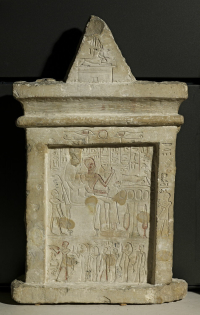


rectangular stele with cornice and pyramidion; stele with two registers; pyramidion
An item at Louvre
Decoration: 1st register; funeral meal; couple (seated, in front of, offering table, breathing, lotus flower); man (2, standing, close-cropped hair, loincloth, offering, bread) 2nd register; procession of relatives; offering scene; man (2, standing); woman (5, standing, offering, bread) chen sign (flanked by); wedjat eye (2); Anubis (above, dog, lying on, corniced base, necklace) (from text)
Department of Egyptian Antiquities
An exhibit at Louvre
The collections of the Department of Egyptian Antiquities present the civilization that evolved on the banks of the Nile, from the end of Prehistory (around 4,000 BCE) to the Christian era (from the 4th century CE).




